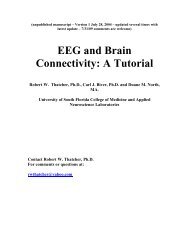Practitioner's Guide to Using Alpha-Stim Practitioner's Guide to ...
Practitioner's Guide to Using Alpha-Stim Practitioner's Guide to ...
Practitioner's Guide to Using Alpha-Stim Practitioner's Guide to ...
Create successful ePaper yourself
Turn your PDF publications into a flip-book with our unique Google optimized e-Paper software.
So Let’s Look at<br />
the Concrete Facts<br />
About <strong>Using</strong><br />
<strong>Alpha</strong>-<strong>Stim</strong> ®<br />
There are only four reasons why a<br />
licensed health care or mental health<br />
professional would recommend any<br />
intervention for a particular patient:<br />
1) Safety<br />
2) Efficacy<br />
3) Cost-Effectiveness<br />
4) Reliability and Support<br />
Through this guide we will demonstrate<br />
how <strong>Alpha</strong>-<strong>Stim</strong> ® meets all four criteria.<br />
<strong>Alpha</strong>-<strong>Stim</strong> ® can easily be incorporated<br />
in<strong>to</strong> your practice resulting in more<br />
satisfied patients who refer friends<br />
and colleagues.<br />
Now let’s look at this in more detail.<br />
<strong>Alpha</strong>-<strong>Stim</strong> ®<br />
and Your Patients<br />
Safety First!<br />
With all the current and on-going<br />
publicity about the dangers of drugs<br />
like Oxycontin, Vioxx, Celebrex, and<br />
the SSRI’s like Prozac, Zoloft and Paxil,<br />
patients are more concerned than ever<br />
about the risks they take when they<br />
seek help for their pain or mood disorders.<br />
<strong>Alpha</strong>-<strong>Stim</strong> ® technology is not only<br />
safer than any drug, but it is even safer<br />
than most other devices because it<br />
only uses microamperes (millionths of<br />
an ampere) of electricity. The only side<br />
effects derived from studies with over<br />
6,000 patients are headache, which<br />
occurs in 1 of 506 patients, and<br />
skin irritation in 1 of 910 patients.<br />
Both of these problems are minor<br />
and self-limiting.<br />
With <strong>Alpha</strong>-<strong>Stim</strong> ® there is no chance<br />
of causing tardive dyskinesia,<br />
increased suicidal ideation, addiction,<br />
death, or hepatic failure, <strong>to</strong> name just<br />
a few of the risks of pharmaceutical<br />
intervention. The worst problem that<br />
has ever been documented with<br />
<strong>Alpha</strong>-<strong>Stim</strong> ® was the rare occurrence<br />
of mild disorientation when a cranial<br />
electrotherapy stimulation (CES)<br />
session was prematurely interrupted.<br />
That problem is easily avoidable by<br />
completing the full treatment session,<br />
which generally takes only 20 minutes.<br />
Proven Efficacy<br />
More than 93% of pain patients<br />
achieve significant relief with <strong>Alpha</strong>-<br />
<strong>Stim</strong> ® , even when conventional<br />
intervention has failed. So how<br />
can you trust this?<br />
There are only three ways <strong>to</strong> prove<br />
efficacy: research, surveys and testimonials.<br />
<strong>Alpha</strong>-<strong>Stim</strong> ® has all three in<br />
abundance. In fact, with 55 completed<br />
studies and many more underway,<br />
there is more research supporting<br />
<strong>Alpha</strong>-<strong>Stim</strong> ® technology than there is for<br />
most drugs. An important fact about<br />
<strong>Alpha</strong>-<strong>Stim</strong> ® research is that none of<br />
it is company-supported. Most of the<br />
studies are double blind placebo<br />
controlled and were conducted at major<br />
US universities. The US government<br />
has funded two major <strong>Alpha</strong>-<strong>Stim</strong> ®<br />
studies. One is a NCI/NIH study for<br />
breast cancer patients undergoing<br />
chemotherapy and the other is a<br />
VA study for veterans with spinal<br />
cord injuries.

















